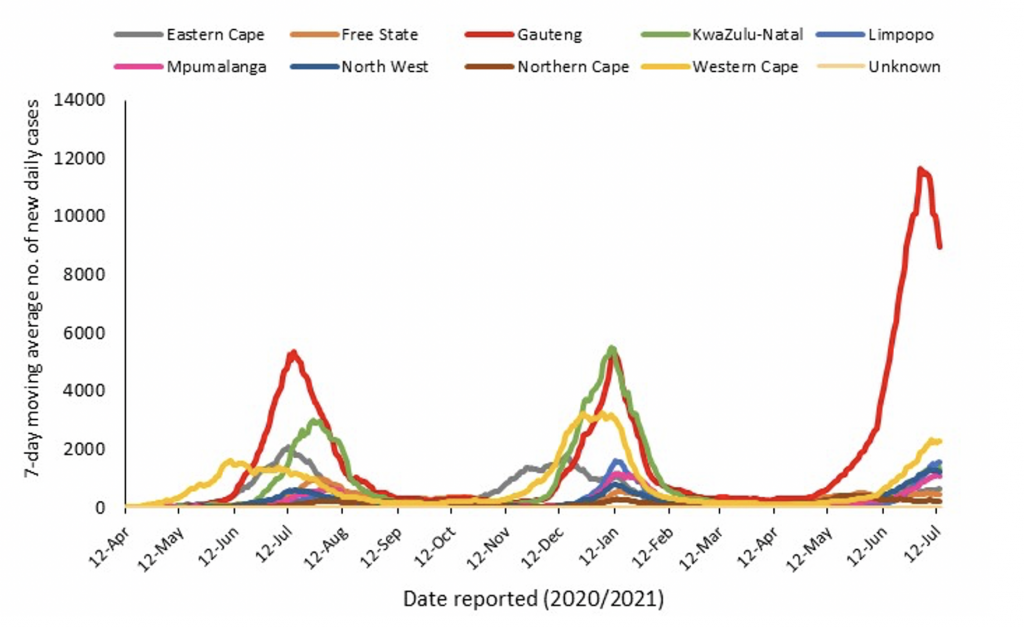The National Institute for Communicable Diseases (NICD), a division of the National Health Laboratory Service, continues the monitoring and surveillance of COVID-19 in order to inform the public health response.
Today the institute reports 16 435 new COVID-19 cases that have been identified in South Africa, which brings the total number of laboratory-confirmed cases to 2 253 240. This increase represents a 29.9% positivity rate.
Although the number of positive cases appears to be decreasing, testing is critical for understanding the spread of COVID-19 infection. It’s crucial to remember that the testing data is representative of those who came forward for testing, not necessarily a reflection of current community transmission in South Africa. Testing data is used to identify cases and follow up of contacts to limit transmission. This data is also used to predict, plan and deploy resources for risk mitigation.
Understanding that services have been adversely affected and services may be temporarily closed we encourage all our communities to seek medical help if they have COVID-19 symptoms such as fever, lethargy, a dry cough, or trouble breathing. Individuals who are unable to access testing facilities and believe they have been infected or have had direct contact with someone who has been confirmed positive should call the COVID -19 hotline on 0800 029 999, stay at home, quarantine for 10 days, and minimise contact with others.
As per the National Department of Health, a further 377 COVID-19 related deaths have been reported, bringing total fatalities to 65 972 to date.
14 100 628 tests have been conducted in both public and private sectors as per the table below.
| Sector | Total tested | New tested | ||
| PRIVATE | 7 915 009 | 56% | 27 085 | 49% |
| PUBLIC | 6 185 619 | 44% | 27 913 | 51% |
| Total | 14 100 628 | 54 998 | ||
PROVINCIAL BREAKDOWN
The majority of new cases today are from Gauteng (44%), followed by Western Cape (18%). Limpopo and North West each accounted for 9%; Mpumalanga accounted for 7%; Eastern Cape accounted for 5%; Free State and KwaZulu-Natal each accounted for 3%; and Northern Cape accounted for 2% of today’s new cases
The cumulative number of cases by province is shown in the table below:
| Province | Total cases for 14 July 2021 | Adjusted numbers after harmonisation | Updated total cases on 14 July 2021 | New cases on 15 July 2021 | Total cases for 15 July 2021 | Percentage total |
| Eastern Cape | 215 663 | 0 | 215 663 | 839 | 216 502 | 9.6 |
| Free State | 121 325 | 1 | 121 326 | 570 | 121 896 | 5.4 |
| Gauteng | 792 130 | 15 | 792 145 | 7 309 | 799 454 | 35.5 |
| KwaZulu-Natal | 372 793 | 2 | 372 795 | 490 | 373 285 | 16.6 |
| Limpopo | 96 116 | 38 | 96 154 | 1 434 | 97 588 | 4.3 |
| Mpumalanga | 109 301 | -1 | 109 300 | 1 078 | 110 378 | 4.9 |
| North West | 113 019 | -55 | 112 964 | 1 515 | 114 479 | 5.1 |
| Northern Cape | 62 334 | 0 | 62 334 | 299 | 62 633 | 2.8 |
| Western Cape | 354 124 | 0 | 354 124 | 2 901 | 357 025 | 15.8 |
| Total | 2 236 805 | 0 | 2 236 805 | 16 435 | 2 253 240 | 100.0 |
THE 7-DAY MOVING AVERAGE NUMBER OF NEW CASES BY PROVINCE
The total number of cases today (n= 16 435) is lower than yesterday (n= 17 489) and lower than the average number of new cases per day over the 7 preceding days (n=16 857).
The 7-day moving average daily number of cases has decreased

7-day moving average number of new cases by province and date of reporting, 12 April 2020 to date, South Africa.
For more detailed information, visit the GIS Dashboard.
HOSPITAL ADMISSIONS
There has been an increase of 726 hospital admissions in the past 24 hours. The following table is a summary of reported COVID-19 admissions by sector.
| Sector | Facilities Reporting | Admissions
to Date |
Died to Date | Currently Admitted |
| Private | 257 | 161 493 | 27 681 | 10 201 |
| Public | 407 | 173 732 | 41 058 | 7 203 |
| TOTAL | 664 | 335 225 | 68 739 | 17 404 |
VACCINE UPDATE
For updates on the national vaccine programme, click here.
Thank you for your interest and remember that adhering to preventative measures limits your risk of contracting and spreading COVID-19. For more information on COVID-19, click here.
Kind regards,
Sinenhlanhla Jimoh, Senior Communications Manager
National Institute for Communicable Diseases


